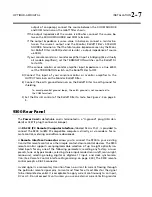
1-18
INTRODUCTION
ORBAN MODEL 9300
or over landlines. Sometimes, several encode/decode cycles will be cascaded before
the material is finally presented to OPTIMOD-AM’s input.
All such algorithms operate by increasing the quantization noise in discrete fre-
quency bands. If not psychoacoustically masked by the program material, this noise
may be perceived as distortion, “gurgling,” or other interference. Psychoacoustic
calculations are used to ensure that the added noise is masked by the desired pro-
gram material and not heard. Cascading several stages of such processing can raise
the added quantization noise above the threshold of masking into audibility. In ad-
dition, at least one other mechanism can cause the noise to become audible at the
radio. OPTIMOD-AM’s multiband limiter performs an “automatic equalization”
function that can radically change the frequency balance of the program. This can
cause noise that would otherwise have been masked to become unmasked because
the psychoacoustic masking conditions under which the masking thresholds were
originally computed have changed.
Accordingly, if you use lossy data reduction in the studio, you should use the highest
data rate possible. This maximizes the headroom between the added noise and the
threshold where it will be heard. In addition, you should minimize the number of
encode and decode cycles because each cycle moves the added noise closer to the
threshold where the added noise is heard.
About Transmission Levels and Metering
Meters
Studio engineers and transmission engineers consider audio levels and their meas-
urements differently, so they typically use different methods of metering to monitor
these levels. The VU meter is an average-responding meter (measuring the approxi-
mate RMS level) with a 300ms rise time and decay time; the VU indication usually
under-indicates the true peak level by 8 to 14dB. The Peak Program Meter (PPM) in-
dicates a level between RMS and the actual peak. The PPM has an attack time of
10ms, slow enough to cause the meter to ignore narrow peaks and under-indicate
the true peak level by 5 dB or more. The absolute peak-sensing meter or LED indica-
tor shows the true peak level. It has an instantaneous attack time, and a release
time slow enough to allow the engineer to read the peak level easily.
shows the relative difference between the absolute peak level, and the indications
of a VU meter and a PPM for a few seconds of music program.
Содержание OPTIMOD-AM 9300
Страница 1: ...Operating Manual OPTIMOD AM 9300 Digital Audio Processor Version 2 0 Software...
Страница 7: ...Operating Manual OPTIMOD AM 9300 Digital Audio Processor Version 2 0 Software...
Страница 178: ...3 46 OPERATION ORBAN MODEL 9300...
Страница 200: ......
Страница 221: ...OPTIMOD AM DIGITAL TECHNICAL DATA 6 21...
Страница 222: ...6 22 TECHNICAL DATA ORBAN MODEL 9300 CONTROL BOARD PARTS LOCATOR...
Страница 228: ...6 28 TECHNICAL DATA ORBAN MODEL 9300...
Страница 229: ...OPTIMOD AM DIGITAL TECHNICAL DATA 6 29 I O DSP BOARD LEFT AND RIGHT ANALOG INPUTS...
Страница 230: ...6 30 TECHNICAL DATA ORBAN MODEL 9300 I O DSP BOARD ANALOG OUTPUTS...
Страница 231: ...OPTIMOD AM DIGITAL TECHNICAL DATA 6 31...
Страница 238: ...6 38 TECHNICAL DATA ORBAN MODEL 9300 FRONT VIEW REAR VIEW FRONT PANEL PARTS LOCATOR DIAGRAM...
Страница 242: ...6 42 TECHNICAL DATA ORBAN MODEL 9300 NOTES...
















































